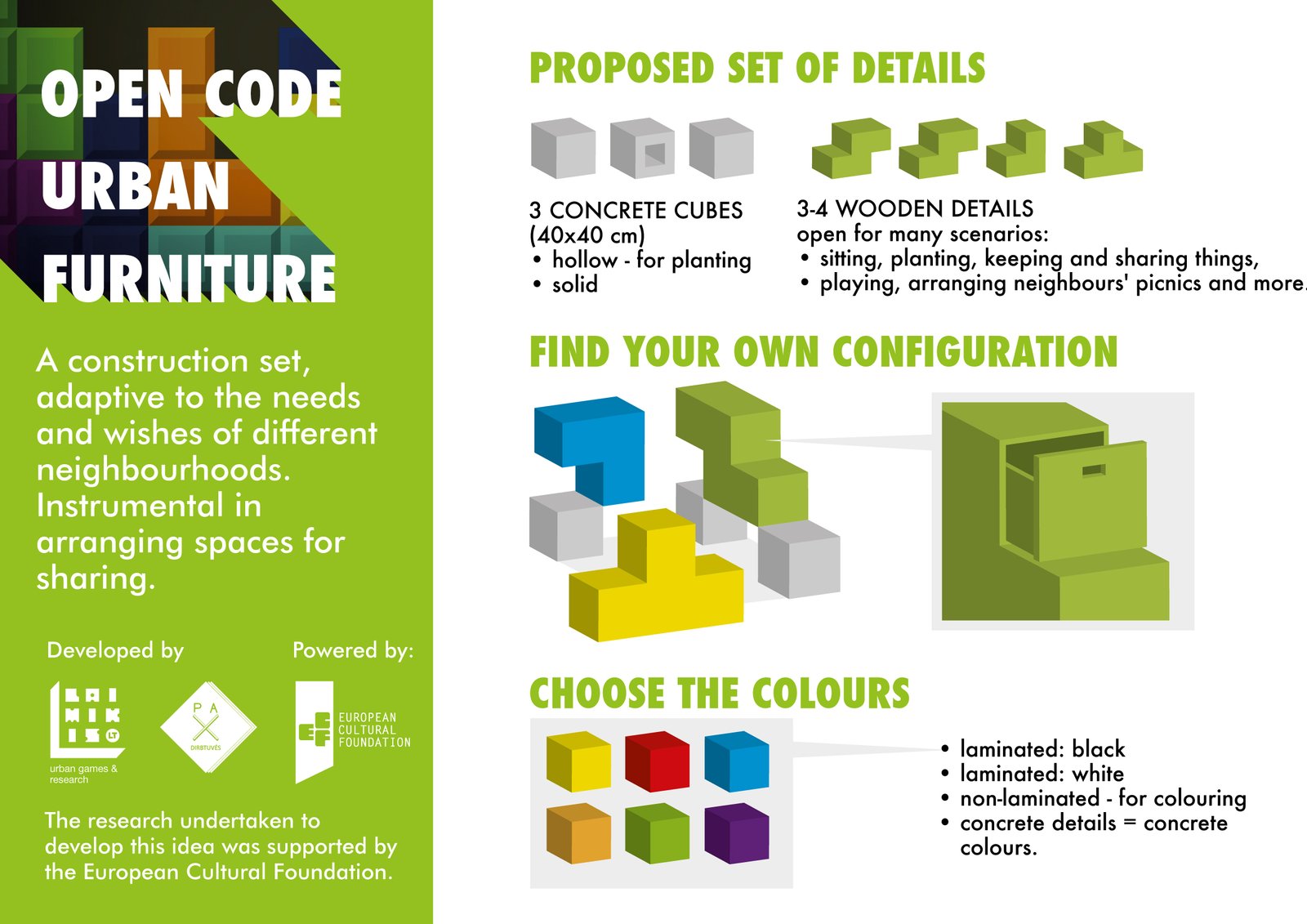Co-design workshops: open code urban furniture (ECF)
Title: Open code urban furniture, co-design workshop
This initiative is part of a bigger networking project, “Public Space Makers”.
Grantee of ECF Design & Research Grant: Jekaterina Lavrinec (Laimikis.lt). Associated partners: Noel Hatch (European Alternatives, UK), Paco Gonzalez (RadarQ, Spain). During the project, co-design workshops are run in London, Barcelona, and Vilnius in cooperation with the local communities. A local organisation – Padirbtuvės – was invited by Laimikis for technical solutions and construction of the furniture set. Valuable improvements of the technical solution were proposed by Šnipiškės-based architect Miroslavas Bielinis.
The idea for Vilnius workshops: A series of open workshops with inhabitants of 4 Vilnius neighbourhoods, in which 4 sets of urban furniture are arranged. From a predesigned placemaking set inhabitants construct their own configuration of urban furniture for the public space they choose and bring new functions to the picked place. A furniture set is also a tool for design-based research on the perception of safety and trust in neighbourhoods and public spaces. Researcher and lead: Jekaterina Lavrinec (Laimikis.lt). Pre-design solution for the furniture: Julius Narkūnas + Jekaterina Lavrinec.


We arranged an open-code urban furniture workshop in the communities which has applied for the workshop, and followed the place that was picked by the local community for the workshop. Lazdynai.

In Šnipiškės, we continued revitalising the Dragon’s field – turning it into a public space. Local children are the active participants of every Laimikis activity here – and in a couple of years with this “learning by doing” approach we fostered very active young cultural actors, who started arranging new public events in the co-designed space! We are very proud of this result :)
What we learned: A set we developed was easy to combine and use, so it did not take long for people to decide on the configuration in each neighbourhood. The colours, however, appeared to have political meaning in one of the neighbourhoods (the community members voted for one party and skipped the colours associated with other political parties). Urban furniture in each neighbourhood was used for 3 years; in one of the neighbourhoods, some modules are still in use! Technical solutions required periodic repairs in neighbourhoods where youngsters actively used furniture. In every neighbourhood, the users found new functions for their furniture set – for example, in Šnipiškės, kids asked to arrange a chess-board and also to paint “1-2-3” at one of the modules – so that they could use it as athletes’ podium during the sports events.

Urban furniture set in Antakalnis – used for picnics by the local community and Antakalnis Urban Lab.

In Šnipiškės the urban furniture was co-designed with kids and they became the most active users of this set. The furniture has become a place for events, which local children started arranging not only for themselves, but also for the community (photo made by the local inhabitant, Miroslavas).
Findings of the design-based research: in Vilnius neighbourhoods, the level of trust in strangers as co-users of public spaces is high. Concerns about a possible mess in public space are mostly vocalised; in this case, drinking persons and teenagers are somehow united as a potential source for a mess. This concern programs the lack of public spaces for teenagers. On the other hand, children appeared to be active co-designers of the spaces in their neighbourhoods. If only given a chance, children discuss urban furniture’s possible configurations and functions in the most fruitful ways. In fact, during this and other activities that the Laimikis team run in public spaces, we are sure that children can be the drivers of public space development. In Šnipiškės, because local children were involved in our creative activities in public spaces for several years, they became active cultural producers at a very young age – 7-11 years.
Outcomes: A placemaking set worked well in every neighbourhood. It grew into new placemaking initiatives developed by the local community in two neighbourhoods. The furniture remained incorporated into the community’s activities for years after the workshop in one neighbourhood. This placemaking set gained expanded functions in every neighbourhood during the 1st year. In Šnipiškės children started arranging their official events around installed urban furniture, inviting adults to participate in the program.
Conclusions: A tetris-like urban furniture set is adaptive to the needs of different neighbourhoods; however, technical adjustments are needed to prolong the life of the furniture to 5-7 years. Placemaking is not about installing something in the public space; it is about the proper co-development process when inhabitants of various ages are truly empowered to continue the development of the place. The indicator for the proper placemaking process is a “social echo effect” (Laimikis term) – prolonging the primary initiatives by the local inhabitants and organisations. We have published the instructions for the open code urban furniture (however, after several years of observations, we suggest technical adjustments to the primary solutions).
Publication based on design-based research:
Lavrinec, J. 2018. Places for Sharing: Tools for Place-making and Social Research // Communities of Practice Towards Social Change (ed. Lore Gablier), ECF / Krytyka Poltyczna, p. 68-75 [slideshare]
More materials:
– Pre-design workshop [Laimikis archive];
– Schemes of the open-code furniture [issuu];
– Co-design workshops in 4 neighbourhoods [Laimikis archive];
– Additional: Leading sketches on the role of urban furniture.
Supported by: CDC Research & Development grant, ECF foundation
Year: 2015

